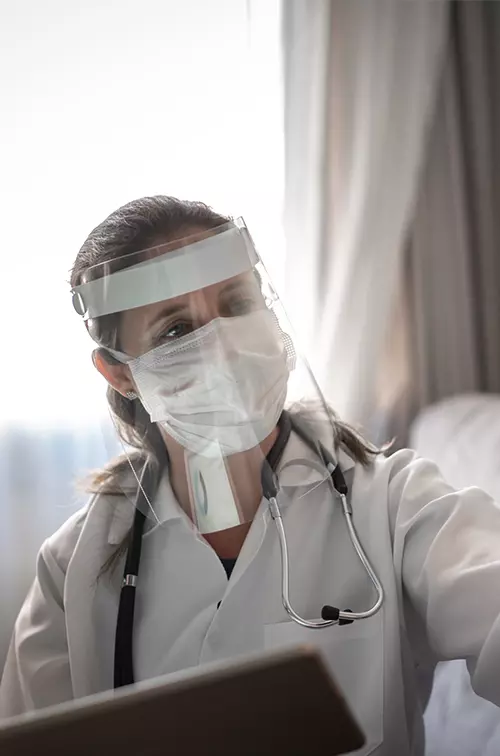Vaccine Schedule
Be sure to complete the consent form before scheduling an appointment.
The schedule will be added soon. Please check back.

AdventHealth Treatment Algorithm for COVID-19
These recommendations are subject to change based on emerging data or drug shortage information.
Central Florida Division Clinical Algorithm for Adults - Hospitalized (Posted 03/02/2023)
Central Florida Division Clinical Algorithm for Adults - Non-Hospitalized (Posted 01/27/2023)
AdventHealth Clinical Pediatric Treatment Algorithm (Posted 06/29/2020)
AdventHealth Clinical NICU Treatment Algorithm (Posted 2/13/2023)
Testing for COVID-19 (CDC Recommendations)
AdventHealth Guidance for Surgical Procedures for COVID-19 during Mitigation and Surge Phases (Posted 04/08/2020)
Coronavirus FAQ for Providers
Direct access to the CDC's updated FAQs for healthcare professionals caring for COVID-19 patients. Click here
- What is the novel coronavirus (COVID-19)?
-
The novel coronavirus is a new coronavirus and the virus that is causing coronavirus disease 2019 (COVID-19). It is not the same as the coronaviruses that commonly circulate among humans and cause mild illness, like the common cold.
Although it is rare for animal coronaviruses to infect and spread between people, this is suspected to have occurred of the virus that causes COVID-19. Middle East Respiratory Syndrome (MERS) and Severe Acute Respiratory Syndrome (SARS) are two other examples of coronaviruses that originated from animals and then spread to people.
Severe acute respiratory syndrome coronavirus 2 (SARS-CoV-2), previously known by the provisional name 2019 novel coronavirus (2019-nCoV), is a positive-sense single-stranded RNA virus. It is contagious in humans and is the cause of coronavirus disease 2019 (COVID-19).
- Where did COVID-19 begin?
-
In late 2019 in Wuhan, China, a novel coronavirus, named acute respiratory syndrome coronavirus 2 (SAR-CoV-2), resulted in an acute respiratory illness epidemic. This illness was then titled Coronavirus Disease 2019 (COVID-19) by the World Health Organization.
- What are the symptoms and how is it transmitted?
-
COVID-19 symptoms many appear 2-14 days after exposure and include fever, coughing and shortness of breath. Most patients with respiratory symptoms do not have COVID-19 and likely to have a more common pathogen (influenza, RSV, other respiratory viruses, bacterial).
The virus causing COVID-19 is thought to spread mainly from person to person.
- Between people who are in close contact with one another (within about six feet).
- Through respiratory droplets produced when an infected person coughs or sneezes.
(It may be possible that a person can get COVID-19 by touching a surface or object that has the virus on it and then touching their own mouth, nose or possibly their eyes, but this is not thought to be the main way the virus spreads.)
Frequently reported signs and symptoms in patients admitted to the hospital include fever (77% to 98%), cough (46% to 82%), myalgia or fatigue (11% to 52%), and shortness of breath (3% to 31%) at illness onset.
COVID-19 is thought to primarily transmitted through person-to-person interactions and close contact of six feet or less via respiratory droplets produced by an infected person’s coughs or sneezes. It is possible that people can be infected by COVID-19 by touching an object surface with the virus on it and then touching their mouth, nose or eyes. COVID-19 has been tested and shown to remain stable on surfaces such as plastic for as long as 72 hours.
If close contact occurs while not wearing all recommended PPE, health care personnel may be at risk of infection.
- How long is the incubation period?
-
The incubation period is estimated at four days (interquartile range: two to seven days). Some studies have estimated a wider range for the incubation period. Data for human infection with other coronaviruses ( MERS-CoV, SARS-CoV) suggest that the incubation period may range from two to 14 days.
- Who is at risk for COVID-19?
-
- Symptomatic individuals, such as older adults and individuals with chronic medical conditions and/or an immunocompromised state that may put them at higher risk for poor outcomes (e.g., diabetes, heart disease, receiving immunosuppressive medications, chronic lung disease, chronic kidney disease).
- Any persons including health care personnel, who within 14 days of symptom onset had close contact with a suspect or laboratory-confirmed COVID-19 patient, or who have a history of travel from affected geographic areas within 14 days of their symptom onset.[RM1]
- How do you test a patient for COVID-19?
-
Clinicians should continue to work with their local and state health departments to coordinate testing through public health laboratories. The Food and Drug Administration (FDA) announced earlier this month that it will move to allow hundreds of labs to be able to test under an Emergency Use Authorization (EUA).
Clinicians should use their judgment to determine if a patient has signs and symptoms compatible with COVID-19 and whether the patient should be tested. Decisions on which patients receive testing should be based on the local epidemiology of COVID-19, as well as the clinical course of illness. Clinicians are strongly encouraged to test for other causes of respiratory illness, including infections such as influenza. They should also notify infection prevention well as their local county health department, even if they have the option to order testing via QUEST, LabCorp or AdventHealth.
- How is COVID-19 treated?
-
There are currently no antiviral drugs licensed by the U.S. Food and Drug Administration (FDA) to treat COVID-19. Some in vitro or in vivo studies suggest potential therapeutic activity of some agents against related coronaviruses, but there are no available data from observational studies or randomized controlled trials in humans to support recommending any investigational therapeutics for patients with confirmed or suspected COVID-19 at this time.
Clinical management includes prompt implementation of recommended infection prevention and control measures and supportive management of complications, including advanced organ support if indicated. Health care personnel should care for patients in an Airborne Infection Isolation Room[RM1] (AIIR).
Approximately 20% to 30% of hospitalized patients with COVID-19 and pneumonia have required intensive care for respiratory support. Among critically ill patients admitted to an intensive care unit, 11% to 64% received high-flow oxygen therapy and 47% to 71% received mechanical ventilation. Some hospitalized patients have required advanced organ support with endotracheal intubation and mechanical ventilation (4% to 42%). A small proportion has also been supported with extracorporeal membrane oxygenation.
- AdventHealth Providers: Cerner orders
-
The following orders are for AdventHealth providers
AdventHealth Central Florida Division facilities:
-
Inpatient and ED Admissions: Coronavirus 2019 PCR
-
Non ED Admissions and Ambulatory/ Out Patient: Coronavirus 2019 PCR Sendout
AdventHealth Multistate Division facilities:
-
Coronavirus 2019 PCR
-
- What isolation gowns are appropriate for use in the care for COVID-19 patients?
-
The CDC does not require gowns that conform to any standard; washable and disposable gowns may be used.
- We are being asked to reuse gowns. Is that appropriate?
-
The CDC indicates that in time of shortage of PPE, that reuse of gowns is an acceptable method to conserve supply for all team members. Please know that AdventHealth is utilizing extraordinary measures to procure additional PPE and will continue to do so. Additional strategies utilized by AdventHealth to reduce the use of PPE include restriction of visitation, elimination of elective surgeries, instituting a work from home policy for appropriate team members, and the use of telemedicine.
- Are we to reuse gowns intended to be disposable?
-
The CDC indicates that disposable gowns are not typically amenable to reuse due to breakage of ties and or fasteners with removal. However, if these remain intact, the gown could be reused. Either cloth or disposable gowns should be removed if soiled; disposable gowns should be discarded, and cloth gowns laundered.
- What is ‘Extended Use’ of an isolation gown?
-
Extended Use refers to the situation in which the caregiver is able to wear the same gown when interacting with more than one patient known to be infected with the same infectious disease, such as COVID-19 positive patients in a cohorted unit. This can be considered as long as there are no additional co-infectious diagnoses transmitted by contact such as C. difficile among patients. If the gown becomes visibly soiled, it should be changed.
- What is ‘Reuse’ of an isolation gown?
-
Reuse refers to a situation in which a caregiver removes his or her unsoiled isolation gown after caring for a patient, and after appropriate hand washing/sanitization subsequently utilizes that same unsoiled isolation gown with the same patient at the time of their next encounter. Reuse of isolation gowns during times of PPE shortage is prioritized first for those patients who are not suspected or confirmed COVID-19.
Coronavirus (COVID-19): Your Questions Answered
For up-to-date information information about the novel coronavirus pandemic, please review our resources and look to trusted sources like the Centers for Disease Control and Prevention (CDC).
AdventHealth Treatment Algorithm for Adults - Hospitalized | AdventHealth Treatment Algorithm for Adults - Non-Hospitalized | AdventHealth Treatment Algorithm for Pediatrics | AdventHealth Treatment Algorithm for NICU | AdventHealth Guidance for Surgical Procedures for COVID-19 during Mitigation and Surge Phases

Monoclonal Antibody Therapy
Blog: Outpatient Treatment Reduces COVID-19 Severity in High-risk Patients
Central Florida physicians can help their non-hospitalized, high-risk COVID-19 patients avoid potential hospitalization, intubation and death by referring them to an AdventHealth outpatient infusion center for monoclonal antibody therapy.
Clinically Approved Demonstration Videos
-
Proper Handwashing Technique
-
Donning and Doffing of PPE

Trusted Resources
For the most timely and up-to-date information on the novel coronavirus, use the following resources:
State Department of Health sites:
U.S. Department of Health and Human Services
American College of Surgeons Bulletin: ACS COVID-19 Newsletter
Important Documents
- AdventHealth COVID-19 Treatment Algorithm for Adults - Hospitalized
- AdventHealth COVID-19 Treatment Algorithm for Adults - Non-Hospitalized
- AdventHealth COVID-19 Treatment Algorithm for Pediatrics
- AdventHealth COVID-19 Treatment Algorithm for NICU
- COVID-19 Intubation Protocol
- AdventHealth COVID-19 Treatment Algorithm for Ophthalmology
- AdventHealth COVID-19 Treatment Algorithm for Anesthesia



